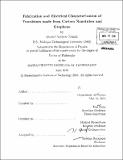| dc.contributor.advisor | Jing Kong and Mildred Dresselhaus. | en_US |
| dc.contributor.author | Nezich, Daniel Andrew | en_US |
| dc.contributor.other | Massachusetts Institute of Technology. Dept. of Physics. | en_US |
| dc.date.accessioned | 2011-05-09T15:14:31Z | |
| dc.date.available | 2011-05-09T15:14:31Z | |
| dc.date.copyright | 2010 | en_US |
| dc.date.issued | 2010 | en_US |
| dc.identifier.uri | http://hdl.handle.net/1721.1/62651 | |
| dc.description | Thesis (Ph. D.)--Massachusetts Institute of Technology, Dept. of Physics, 2010. | en_US |
| dc.description | Cataloged from PDF version of thesis. | en_US |
| dc.description | Includes bibliographical references (p. 247-256). | en_US |
| dc.description.abstract | Carbon nanotubes and graphene are low-dimensional allotropes of carbon which exhibit novel mechanical and electrical properties. The methods for producing these materials and fabricating electronic devices from them are still under development. This thesis uses the fabrication and electronic analysis of field-effect transistors made from carbon nanotubes and graphene to gain insights into the growth process of these materials, to understand complications of the fabrication process, and to assess the quality of the materials through their electronic properties. The numbers of semoconducting and metallic nanotubes produced by growth using two different catalysts are counted by the process of electrical cutting. Various highcurrent phenomena are observed and explained through use of multi-nanotube and charge leakage models. The high-current annealing method discovered for nanotubes is found to also be useful for improving the quality of graphene devices. The graphene used for device fabrication is produced by thermal chemical vapor deposition on thin film nickel. The large area and weak adhesion of this material leads to the alteration of device designs and fabrication procedures, including substrate exposure and high-temperature annealing. A new nanofluidic device is introduced to study the enhanced lateral wet etching rate of materials in contact with graphene. Two sets of graphene field-effect transistors are analyzed, a first for this type of material. Improved material quality results in improved electrical mobility. Two independent models are derived which relate the thickness of a graphene film to its gate-voltage dependent behaviour, and are justified by experiment. Temperature dependence, quantum capacitance, and multiterminal measurements are discussed. | en_US |
| dc.description.statementofresponsibility | by Daniel Andrew Nezich. | en_US |
| dc.format.extent | 256 p. | en_US |
| dc.language.iso | eng | en_US |
| dc.publisher | Massachusetts Institute of Technology | en_US |
| dc.rights | M.I.T. theses are protected by
copyright. They may be viewed from this source for any purpose, but
reproduction or distribution in any format is prohibited without written
permission. See provided URL for inquiries about permission. | en_US |
| dc.rights.uri | http://dspace.mit.edu/handle/1721.1/7582 | en_US |
| dc.subject | Physics. | en_US |
| dc.title | Fabrication and electrical characterization of transistors made from carbon nanotubes and graphene | en_US |
| dc.title.alternative | Fabrication and electronic characterization of transistors made from carbon nanotubes and graphene | en_US |
| dc.type | Thesis | en_US |
| dc.description.degree | Ph.D. | en_US |
| dc.contributor.department | Massachusetts Institute of Technology. Department of Physics | |
| dc.identifier.oclc | 713655500 | en_US |
